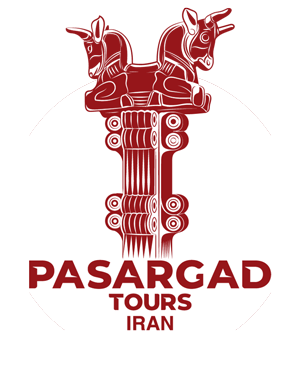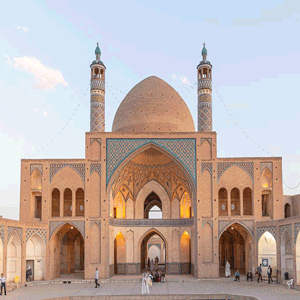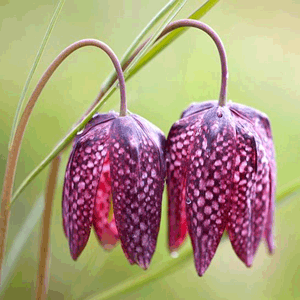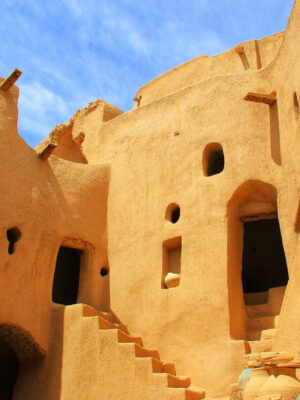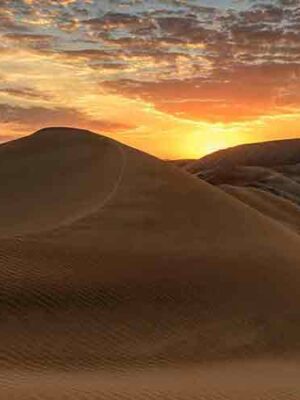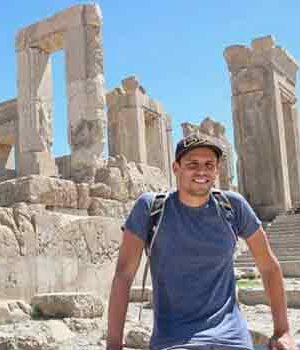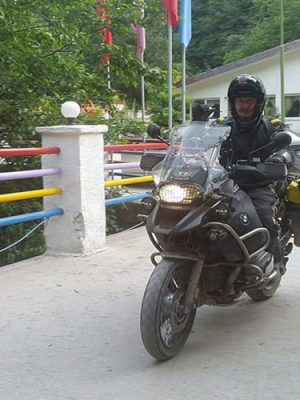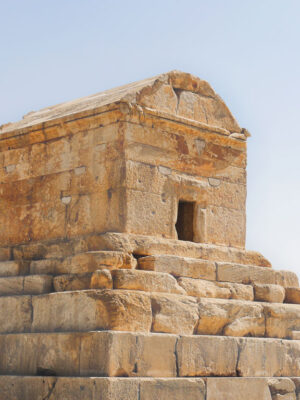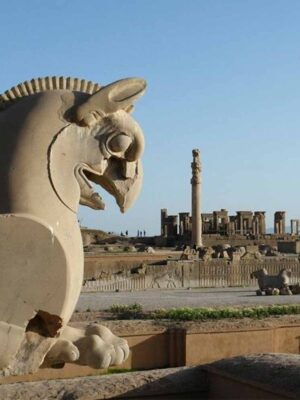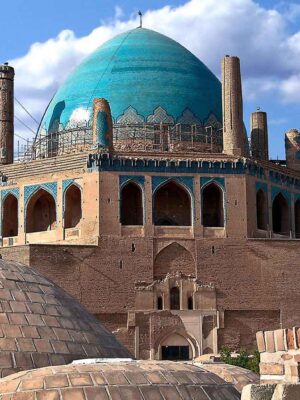Tabiat Bridge
If you are traveling to Iran, make sure to visit Tabiat Pedestrian Bridge. Located at the heart of the capital, Tehran, this structure has gained a cultural status comparable to monuments like Milad and Azadi Towers. Its importance may even be compared to the historic bridges of Zayandeh Rud in Isfahan. Being the largest pedestrian bridge in Iran, it connects two of the largest parks of Tehran. Yet its cultural importance resides not only in its size and beauty but in the fact that it was designed by a talented young woman. It is considered as a testament to the capability and creativity of modern Iranian women, their interconnection with nature and Iranian culture.
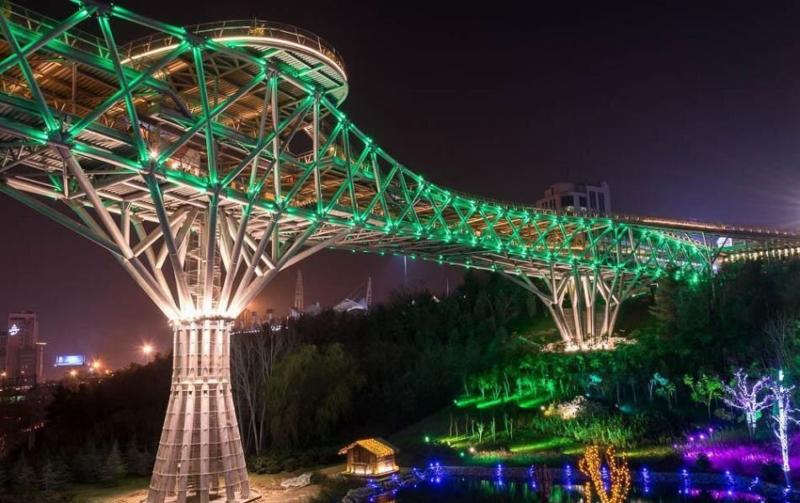
Tabiat Bride lit up at night. The bridge lighting changes to accommodate various dates of national and international events
History of Tabiat Bridge
Designed by Leila Araghian and Alireza Behzadi Tabiat (“nature”) Bridge construction started in 2010 and finished in 2014. While Iran was under international sanctions at the time of construction, international companies involved in the project caused some delays. But perhaps this nuisance served to improve the cultural status of the bridge: As the “Build a Wall” slogan was taking root in the western hemisphere, Iranians were investing their efforts into building a “Bridge”; A structure that not only connects two points in Iranian culture but is a place to enjoy and contemplate the connection. The enthusiast designer, being influenced by her rich heritage stated once: “I didn’t want it to be just a bridge which people would use to get from one park to another, I wanted it to be a place for people to stay and ponder, not simply pass”.
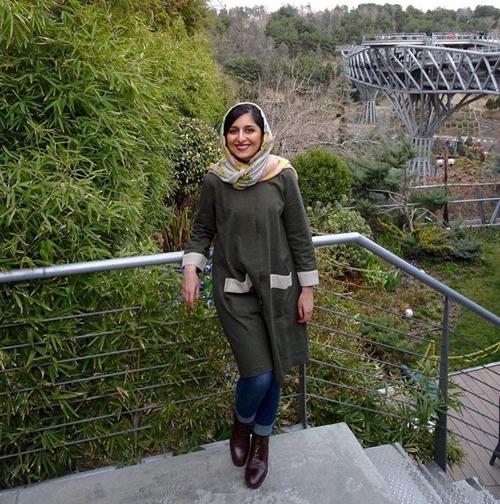
Leila Araghian in front of Tabiat Bridge
The design of the Tabiat Bridge has won several awards. Most notable of these awards include Popular Choice Prize for Highways & Bridges from the Architizer A+ Awards and Aga Khan Award for Architecture.
Design Overview of Tabiat Bridge
Influenced mainly by Khaju Bridge, Tabiat Bridge’s design is certainly a modern one. The curves and pillars are the artist’s impression of Trees and nature surrounding this enormous structure. Such an approach provides the Bridge a notable consistency with its surrounding environment. The wooden flooring also helps connect the bridge to its environment. Yet its robust steel composition accentuates the contemporary architecture. The 270 meters long Tabiat Bridge consists of three interconnected floors that merge into the topography of the two parks.
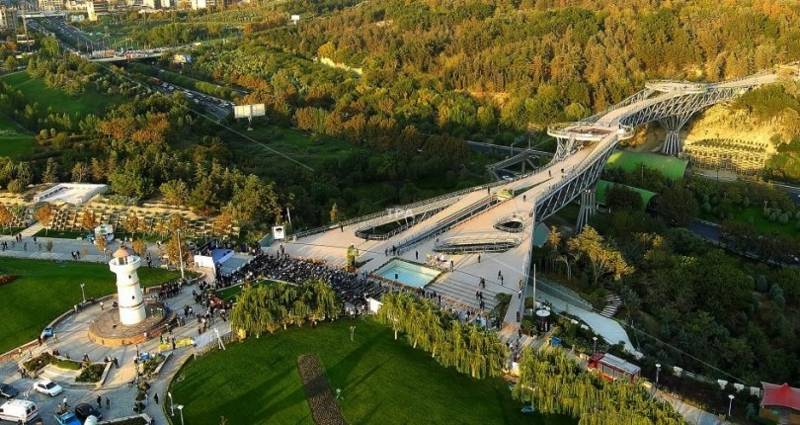
Aerial View of Tabiat Bridge
First Floor
With 1450 square meters, this floor houses a gallery, several coffee shops, and restaurants, and a food court. The walls on this floor are made of glass in order to control the highway noise. For people who take pleasure in eating in public places, this floor might prove to be the most enjoyable one! These cafes and restaurants serve a variety of Iranian and international foods to accommodate your tastes. Above all, Having a marvelous view of the Alborz mountains and an overview of trees covering beautiful parks make for perfect outdoor dining. You may also have the option to pick a seat with a view of Tehran city if you prefer to maintain more of a city life experience.
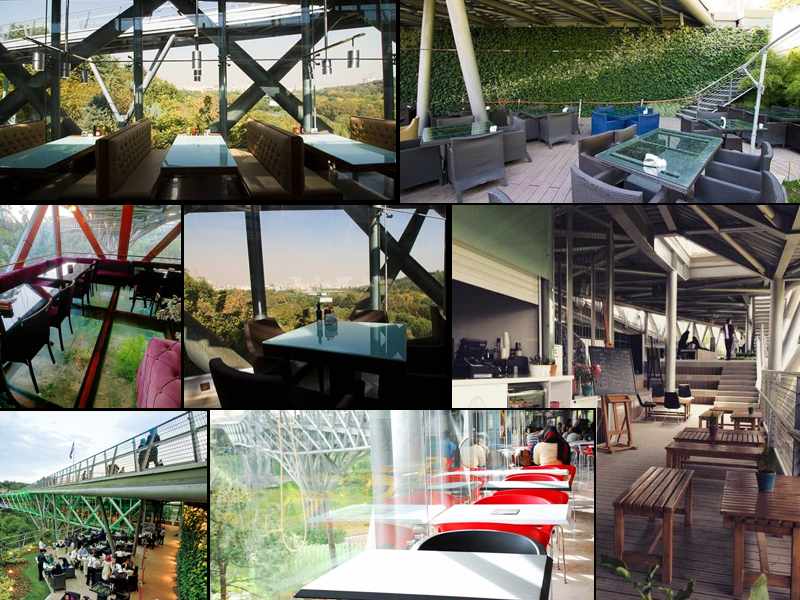
Interior View of Tabiat Bridge Cafes and Restaurants
Second Floor
The second floor is dedicated to quick passage. Yet it has two platforms at north and south to get a thrill out of the scenery. These platforms are often occupied by painters and photographers who search for metropolitan inspirations. In addition, these platforms serve as a resting station for the people crossing the bridge. There are some benches available on this floor as well in case you feel the need to relax your feet.
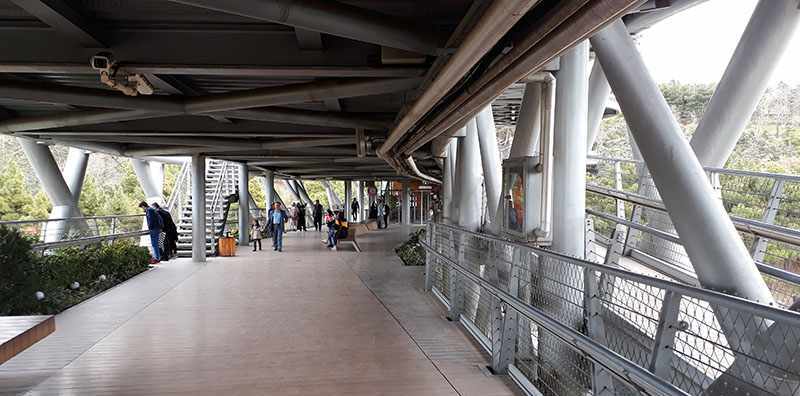
Second Floor of Tabiat Bridge
Third Floor
With a height of 40 meters above ground, this is the topmost floor of the bridge. The keen resemblance to the Khaju bridge might become most noticeable on this floor. Unobstructed view of the surrounding area as well as the sky makes for a perfect crossing experience. In good weather, the scent of trees and flora makes the passage over this floor a memorable one. Also, along with a moonlit sky, you could have a more romantic experience.
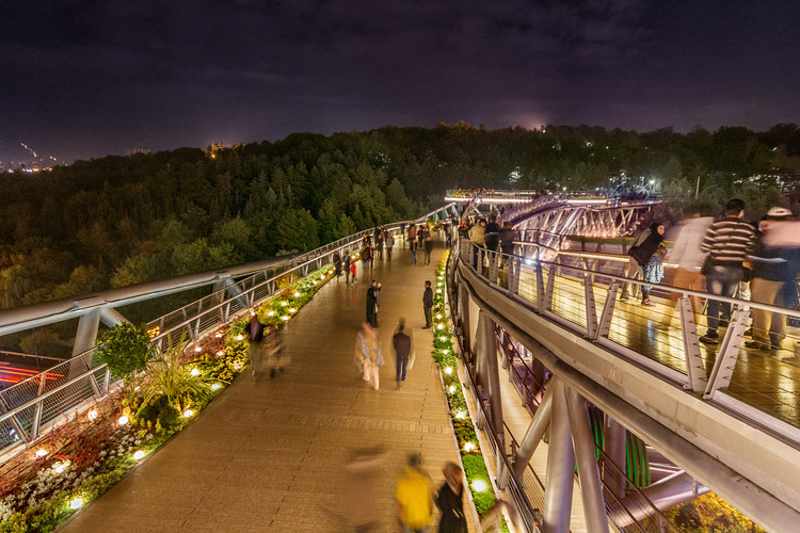
View from 3rd Floor of Tabiat Bridge
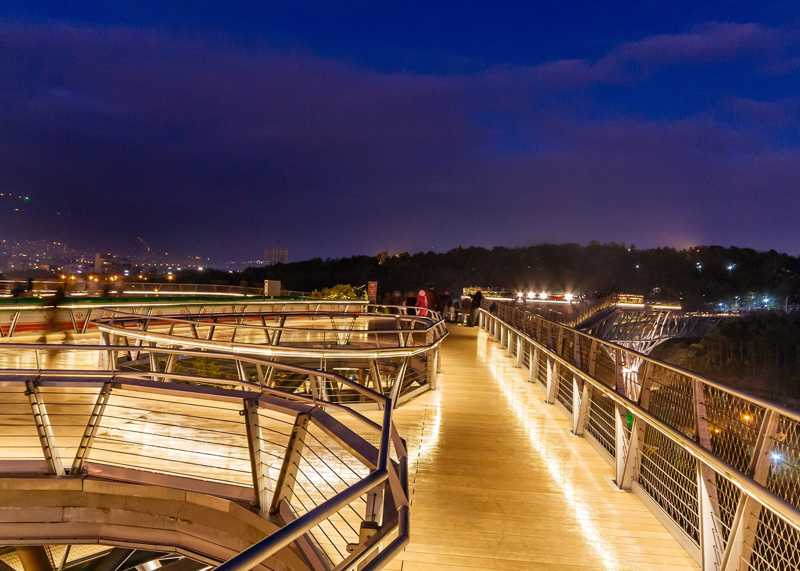
View from Third Floor of Tabiat Bridge
Location of Tabiat Bridge
Tabiat Bridge is indeed an architectural marvel. But its’ significance is partly due to its location. It crosses over Modarres highway, connecting Taleghani Forest Park and Abo-Atash (“Water & Fire”) park. Since Tabiat Bridge and the parks complement each other, a brief introduction of these two parks is somewhat necessary. After all, a visit to each of these landmarks impels the curious visitor to stop by the other two.
Taleghani Forest Park
Commissioned in 1971 and completed in 1982, Taleghani Forest Park was built in an area of 310 thousand square meters. Amongst the variety of trees covering the park, the most noticeable are Italian Oaks which is an endangered species. Decorated with wooden walkways and arbors, it fulfills your quest for a perfect “walk in a park”. Providing a natural habitat, the birds take refuge in it from the city life of Tehran. So do the people for the grace of clean air and the calm environment it imparts.
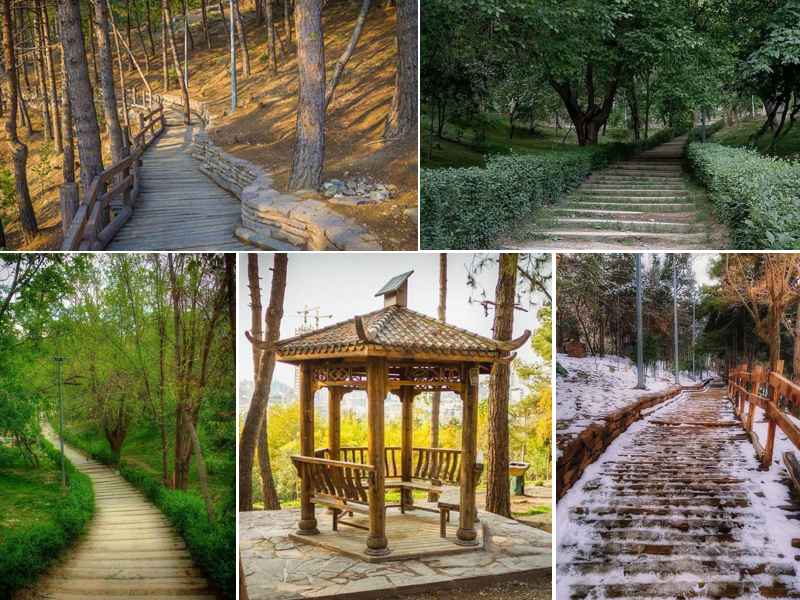
Taleghani Forest Park in Four Seasons
Taleghani Park also houses Iran’s biggest Flag. Which is in place atop the third tallest flagpole in the world. The flag is visible both from within the park and outside. The flag of Iran is displaced by a black flag at the time of Ashura.
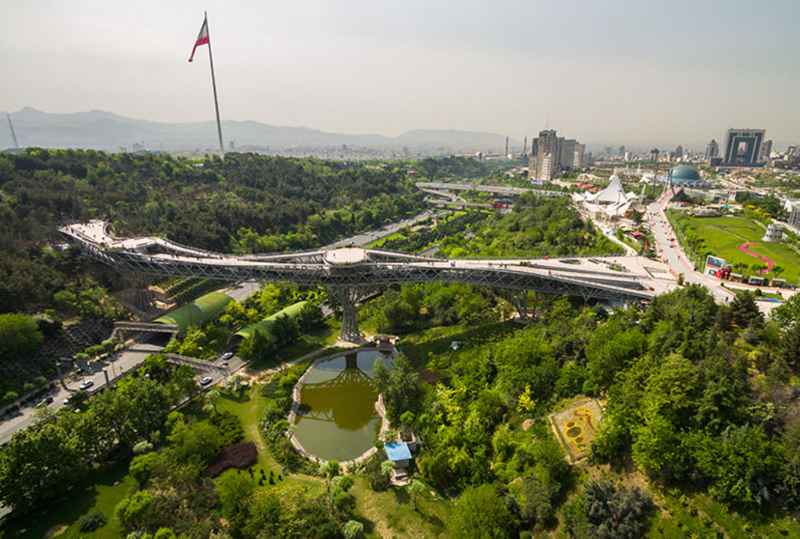
Flag of Iran, in Taleghani forest Park (Left), Tabiat Bridge (center), Abo-Atash Park (right)
Abo-Atash Park
An informative description of this park deserves a full article. But there is room for a few words and pictures to quench the curiosity of the reader. This second park, at the western wing of the Tabiat Bridge, is named after its two distinctive features. A water-playing area and four fire towers making flames as high as 8 meters. On special occasions, there is live music performance during presentations. Also known as Ibrahim’s Park (After the statues depicting the story of the great prophet Abraham who passed through fire unharmed) covers an area of about 24 thousand square meters. Opened to the public in 2009, It includes an amphitheater, a lighthouse, gazebos, botanic garden, Mina Dome observatory, Caspian artificial lake, and a myriad of restaurants and food courts.
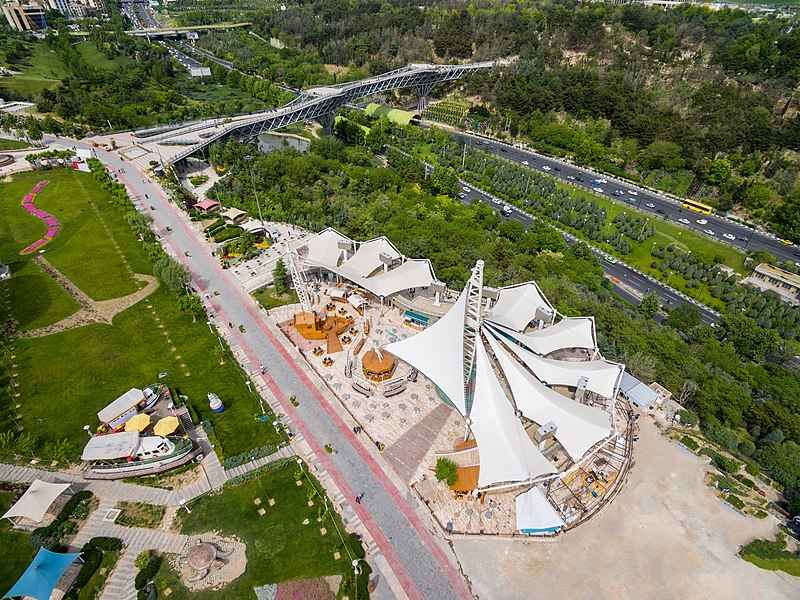
Aerial View of Abo-Atash Park
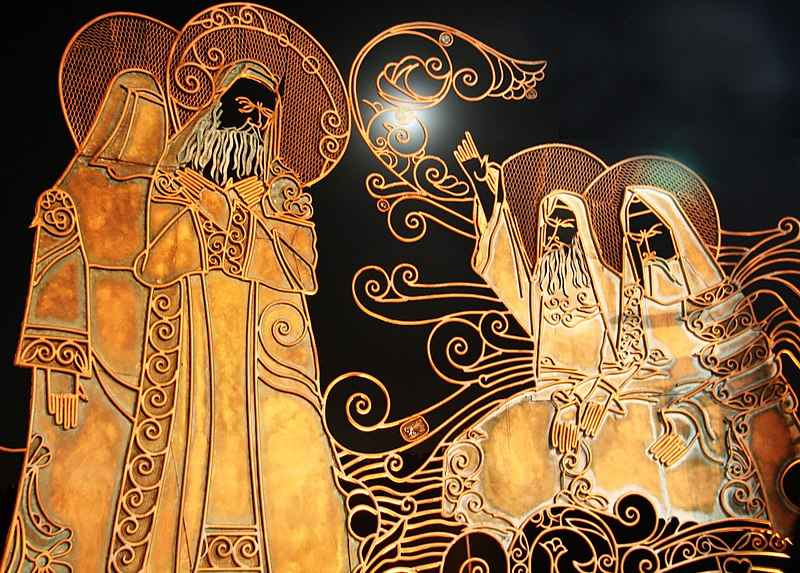
Statue of Ibrahim in Abo-Atash Park
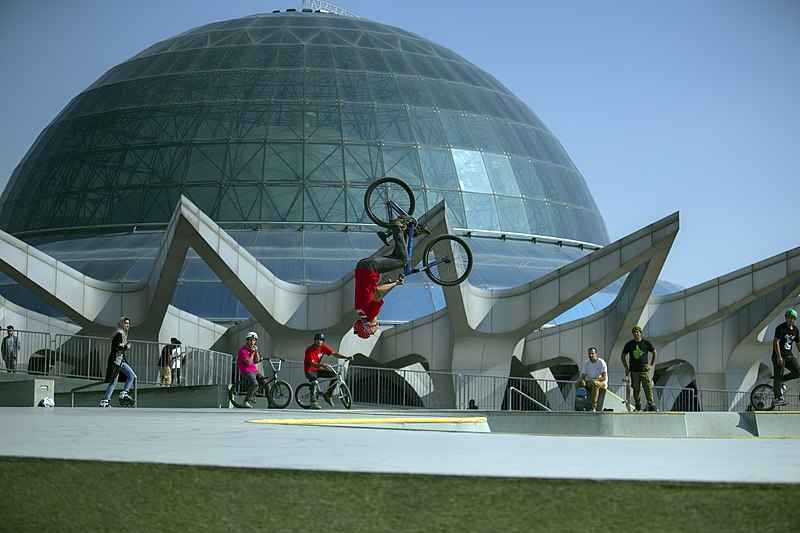
Bicycle performance in front of Mina Dome Observatory
Best time to visit Tabiat Bridge & Adjacent Parks
Visiting Tabiat Bridge and the parks it connects to is possible in all four seasons. Yet the best time to visit depends completely on the visitor. If you are someone who enjoys the heat of the summer and its long days, then summer would suit you best. If you are a Spring person and love to spend time with the crowd enjoying their holiday then spring would be the best season to visit. Colorful autumn would be best if you like to see a thousand colors of the trees. Perhaps it is only winter that requires a bit of luck, so you can visit the bridge and the parks covered under a blanket of snow, letting you mark every step of your passage. For reservations and more information about our tours, contact us at Pasargad Tours.
Tabiat Bridge
If you are traveling to Iran, make sure to visit Tabiat Pedestrian Bridge. Located at the heart of the capital, Tehran, this structure has gained a cultural status comparable to monuments like Milad and Azadi Towers. Its importance may even be compared to the historic bridges of Zayandeh Rud in Isfahan. Being the largest pedestrian bridge in Iran, it connects two of the largest parks of Tehran. Yet its cultural importance resides not only in its size and beauty but in the fact that it was designed by a talented young woman. It is considered as a testament to the capability and creativity of modern Iranian women, their interconnection with nature and Iranian culture.

Tabiat Bride lit up at night. The bridge lighting changes to accommodate various dates of national and international events
History of Tabiat Bridge
Designed by Leila Araghian and Alireza Behzadi Tabiat (“nature”) Bridge construction started in 2010 and finished in 2014. While Iran was under international sanctions at the time of construction, international companies involved in the project caused some delays. But perhaps this nuisance served to improve the cultural status of the bridge: As the “Build a Wall” slogan was taking root in the western hemisphere, Iranians were investing their efforts into building a “Bridge”; A structure that not only connects two points in Iranian culture but is a place to enjoy and contemplate the connection. The enthusiast designer, being influenced by her rich heritage stated once: “I didn’t want it to be just a bridge which people would use to get from one park to another, I wanted it to be a place for people to stay and ponder, not simply pass”.

Leila Araghian in front of Tabiat Bridge
The design of the Tabiat Bridge has won several awards. Most notable of these awards include Popular Choice Prize for Highways & Bridges from the Architizer A+ Awards and Aga Khan Award for Architecture.
Design Overview of Tabiat Bridge
Influenced mainly by Khaju Bridge, Tabiat Bridge’s design is certainly a modern one. The curves and pillars are the artist’s impression of Trees and nature surrounding this enormous structure. Such an approach provides the Bridge a notable consistency with its surrounding environment. The wooden flooring also helps connect the bridge to its environment. Yet its robust steel composition accentuates the contemporary architecture. The 270 meters long Tabiat Bridge consists of three interconnected floors that merge into the topography of the two parks.

Aerial View of Tabiat Bridge
First Floor
With 1450 square meters, this floor houses a gallery, several coffee shops, and restaurants, and a food court. The walls on this floor are made of glass in order to control the highway noise. For people who take pleasure in eating in public places, this floor might prove to be the most enjoyable one! These cafes and restaurants serve a variety of Iranian and international foods to accommodate your tastes. Above all, Having a marvelous view of the Alborz mountains and an overview of trees covering beautiful parks make for perfect outdoor dining. You may also have the option to pick a seat with a view of Tehran city if you prefer to maintain more of a city life experience.

Interior View of Tabiat Bridge Cafes and Restaurants
Second Floor
The second floor is dedicated to quick passage. Yet it has two platforms at north and south to get a thrill out of the scenery. These platforms are often occupied by painters and photographers who search for metropolitan inspirations. In addition, these platforms serve as a resting station for the people crossing the bridge. There are some benches available on this floor as well in case you feel the need to relax your feet.

Second Floor of Tabiat Bridge
Third Floor
With a height of 40 meters above ground, this is the topmost floor of the bridge. The keen resemblance to the Khaju bridge might become most noticeable on this floor. Unobstructed view of the surrounding area as well as the sky makes for a perfect crossing experience. In good weather, the scent of trees and flora makes the passage over this floor a memorable one. Also, along with a moonlit sky, you could have a more romantic experience.

View from 3rd Floor of Tabiat Bridge

View from Third Floor of Tabiat Bridge
Location of Tabiat Bridge
Tabiat Bridge is indeed an architectural marvel. But its’ significance is partly due to its location. It crosses over Modarres highway, connecting Taleghani Forest Park and Abo-Atash (“Water & Fire”) park. Since Tabiat Bridge and the parks complement each other, a brief introduction of these two parks is somewhat necessary. After all, a visit to each of these landmarks impels the curious visitor to stop by the other two.
Taleghani Forest Park
Commissioned in 1971 and completed in 1982, Taleghani Forest Park was built in an area of 310 thousand square meters. Amongst the variety of trees covering the park, the most noticeable are Italian Oaks which is an endangered species. Decorated with wooden walkways and arbors, it fulfills your quest for a perfect “walk in a park”. Providing a natural habitat, the birds take refuge in it from the city life of Tehran. So do the people for the grace of clean air and the calm environment it imparts.

Taleghani Forest Park in Four Seasons
Taleghani Park also houses Iran’s biggest Flag. Which is in place atop the third tallest flagpole in the world. The flag is visible both from within the park and outside. The flag of Iran is displaced by a black flag at the time of Ashura.

Flag of Iran, in Taleghani forest Park (Left), Tabiat Bridge (center), Abo-Atash Park (right)
Abo-Atash Park
An informative description of this park deserves a full article. But there is room for a few words and pictures to quench the curiosity of the reader. This second park, at the western wing of the Tabiat Bridge, is named after its two distinctive features. A water-playing area and four fire towers making flames as high as 8 meters. On special occasions, there is live music performance during presentations. Also known as Ibrahim’s Park (After the statues depicting the story of the great prophet Abraham who passed through fire unharmed) covers an area of about 24 thousand square meters. Opened to the public in 2009, It includes an amphitheater, a lighthouse, gazebos, botanic garden, Mina Dome observatory, Caspian artificial lake, and a myriad of restaurants and food courts.

Aerial View of Abo-Atash Park

Statue of Ibrahim in Abo-Atash Park

Bicycle performance in front of Mina Dome Observatory
Best time to visit Tabiat Bridge & Adjacent Parks
Visiting Tabiat Bridge and the parks it connects to is possible in all four seasons. Yet the best time to visit depends completely on the visitor. If you are someone who enjoys the heat of the summer and its long days, then summer would suit you best. If you are a Spring person and love to spend time with the crowd enjoying their holiday then spring would be the best season to visit. Colorful autumn would be best if you like to see a thousand colors of the trees. Perhaps it is only winter that requires a bit of luck, so you can visit the bridge and the parks covered under a blanket of snow, letting you mark every step of your passage. For reservations and more information about our tours, contact us at Pasargad Tours.




